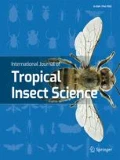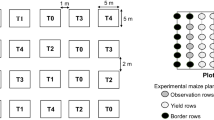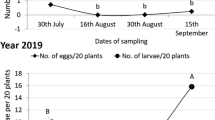Abstract
The appearance and rapid spread of the fall armyworm (Spodoptera frugiperda) (FAW) represents a serious threat to maize cultivation in India and elsewhere in South Asia. Chemical control illustrates one of the major means of reducing the infestation of FAW in maize-growing zones. However, existing information regarding the field-efficacy and non-target toxicity of different insecticides against this pest is not adequate and is also unable to capture the momentum change in the scenario of residual toxicity and insecticide resistance for redacting sustainable management. The present study was framed to establish the most suitable insecticidal schedule against FAW for maize producers. In the period from winter 2019–2020 to spring–summer 2020, seven treatment schedules against FAW were evaluated, and the efficacy was calculated according to the per cent maize plant damage (PD) by larvae, while safety was enumerated based on larval parasitization by Campoletis chlorideae and the abundance of coccinellid predators. In both seasons, the highest cumulative efficacy (9.88 and 10.19% PD) was confirmed for T3 (constituted with Barazide®, Delegate®, and Ampligo®) with a significantly higher yield (52.39 and 52.66 q ha−1), whereas T7 (Proclaim Fit®, Ampligo®, and Delegate®) and T6 (Fimecta®, Ampligo®, and Spintor®) exhibited a high cumulative efficacy (11.06 to 12.23% PD). T3 was found to be safe to coccinellid predators and the per cent larval parasitism by C. chlorideae was significantly higher in this module (2.57 and 2.75%) compared to T4 and T5 (1.00 to 1.67%). The residues of Barazide®, Delegate®, and Ampligo® were below detectable levels in maize plant, grain and soil samples. Therefore, the module could be recommended against FAW in the near future.






Similar content being viewed by others
References
(POP) Package of Practice for the management of fall army worm (2019) Directorate of Plant Protection, Quarantine and Storage, Government of India. http://ppqs.gov.in/sites/default/files/pop_sorghum.pdf. Accessed 20 Dec 2019
(SFCPB) Safety of the Food Chain Pesticides and Biocides (2018) European Commission, Directorate General for Health and Food Safety. https://ec.europa.eu/food/sites/food/files/plant/docs/pesticides_mrl_guidelines_wrkdoc_2017-11813.pdf2017-11813.pdf. Accessed 25 Aug 2020
Anastassiades M, Lehotay SJ, Stajnbaher D, Schenck FJ (2003) Fast and easy multiresidue method employing acetonitrile extraction/partitioning and “dispersive solid-phase extraction” for the determination of pesticide residues in produce. J AOAC Int 86(2):412–431. https://doi.org/10.1093/jaoac/86.2.412
Assefa F, Ayalew D (2019) Status and control measures of fall armyworm (Spodoptera frugiperda) infestations in maize fields in Ethiopia: A review. Cogent Food Agric 5(1):1641902. https://doi.org/10.1080/23311932.2019.1641902
Belay DK, Huckaba RM, Foster JE (2012) Susceptibility of the fall armyworm, Spodoptera frugiperda (Lepidoptera: Noctuidae), at Santa Isabel, Puerto Rico, to different insecticides. Fla Entomol 95(2):476–478. https://doi.org/10.1653/024.095.0232
Blanco CA, Chiaravalle W, Dalla-Rizza M, Farias J, Garcia-Degano M, Gastaminza G, Pieralisi B (2016) Current situation of pests targeted by Bt crops in Latin America. Curr Opinion Insect Sci 15:131–138. https://doi.org/10.1016/j.cois.2016.04.012
Brady JA, Wallender WW, Werner I, Fard BM, Zalom FG, Oliver MN, Wilson BW, Mata MM, Henderson JD, Deanovic LA, Upadhaya S (2006) Pesticide runoff from orchard floors in Davis, California, USA: a comparative analysis of diazinon and fenvalerate. Agric Ecosyst Environ 115(1–4):56–68. https://doi.org/10.1016/j.agee.2005.12.009
Cloyd RA, Bethke JA (2011) Impact of neonicotinoid insecticides on natural enemies in greenhouse and interiorscape environments. Pest Manag Sci 67(1):3–9. https://doi.org/10.1002/ps.2015
Cruz I, Figueiredo MDLC, Silva RBD, Silva IFD, Paula CD, Foster JE (2012) Using sex pheromone traps in the decision-making process for pesticide application against fall armyworm (Spodoptera frugiperda [Smith] [Lepidoptera: Noctuidae]) larvae in maize. Int J Pest Manag 58(1):83–90. https://doi.org/10.1080/09670874.2012.655702
Deshmukh S, Pavithra HB, Kalleshwaraswamy CM, Shivanna BK, Maruthi MS, Mota-Sanchez D (2020) Field efficacy of insecticides for management of invasive fall armyworm, Spodoptera frugiperda (J. E. Smith) (Lepidoptera: Noctuidae) on maize in India. Fla Entomol 103(2):221–227. https://doi.org/10.1653/024.103.0211
Deshpande C (2019) Pesticide residue in armyworm-hit maize killing cattle? The Times of India. https://timesofindia.indiatimes.com/city/nagpur/pesticide-residue-in-armyworm-hit-maize-killing-cattle/articleshow/71140334.cms. Accessed 21 Aug 2020
El-Wakeil N, Gaafar N, Sallam A, Volkmar C (2013) Side effects of insecticides on natural enemies and possibility of their integration in plant protection strategies. In: Trdan S (ed) Insecticides – Development of safer and more effective technologies, IntechOpen. https://doi.org/10.5772/54199
Foster RE (1989) Strategies for protecting sweet corn ears from damage by fall armyworms (Lepidoptera: Noctuidae) in Southern Florida. Fla Entomol 72(1):146–151. https://doi.org/10.2307/3494981
Ghosal A, Chatterjee ML (2017) Novaluron 5.25% + Emamectin benzoate 0.9% SC against Spodoptera litura on cabbage. Pestis Res J 29(2):135–140
Goergen G, Kumar PL, Sankung SB, Togola A, Tamo M (2016) First report of outbreaks of the fall armyworm Spodoptera frugiperda (J.E. Smith) (Lepidoptera: Noctuidae), a new alien invasive pest in west and central Africa. PLoS One 11:e0165632
Gomez KA, Gomez AA (1984) Statistical procedures for agricultural research (2 ed.). John Wiley and sons, New York, 680p
Govindan K, Gunasekaran K, Kuttalam S (2013) Emamectin benzoate 5 SG: A safer insecticide to coccinellids predators in cotton ecosystem. African J Agril Res 8(21):2455–2460. https://doi.org/10.5897/AJAR2013.7167
Gupta RK, Raj D, Devi N (2004) Biological and impact assessment studies on Campoletis chlorideae Uchida: A promising solitary larval endoparasitoid of Helicoverpa armigera (Hubner). J Asia-Pacific Entomol 7(2):239–247. https://doi.org/10.1016/S1226-8615(08)60222-8
Gutierrez-Moreno R, Mota-Sanchez D, Blanco CA, Whalon M, Teran-Santofimio H, Rodriguez-Maciel JC, DiFonzo C (2019) Field-evolved resistance of the fall armyworm (Lepidoptera: Noctuidae) to synthetic insecticides in Puerto Rico and Mexico. J Econ Entomol 112(2):792–802. https://doi.org/10.1093/jee/toy372
Hafez AA, Halawa SM, Gameel SMM, Mahmoud MS (2016) Determination of spinetoram residues degradation in tomato fruits using high performance liquid chromatography (HPLC) and QuECHERS method. Egyptian Scientific J Pestis 2(3):8–12
Hardke JT, Temple JH, Leonard BR, Jackson RE (2011) Laboratory toxicity and field efficacy of selected insecticides against fall armyworm (Lepidoptera: Noctuidae). Fla Entomol 94(2):272–278. https://doi.org/10.1653/024.094.0221
Jaleel W, Saeed S, Naqqash MN, Sial MU, Ali M, Zaka SM, Sarwar ZM, Ishtiaq M, Qayyum MA, Aine QU, Anwar A, Sarmad M, Azad R, Latif M, Ahmed F, Islam W, Khan KA, Ghramh HA (2020) Effects of temperature on baseline susceptibility and stability of insecticides resistance against Plutella xyllostella (Lepidoptera: Plutellidae) in the absence of selection pressure. Saudi J Biol Sci 27(1):1–5. https://doi.org/10.1016/j.sjbs.2019.03.004
Koli P, Bhardwaj NR (2018) Status and use of pesticides in forage crops in India. J Pestic Sci 43(4):225–232. https://doi.org/10.1584/jpestics.D18-004
Kundu SS, Chettri D, Chatterjee S, Mukhopadhyay AK (2018) Evaluation of Novaluron 5.25% + Emamectin benzoate 0.9% SC against yellow stem borer (Scirpophaga incertulas) on rice. J Entomol Zool Stud 6(3):789–792
Li Y, Dou Y, An J, Tu X, Lv H, Pan W, Dang Z, Gao Z (2020) Temperature-dependent variations in toxicity of diamide insecticides against three lepidopteran insects. Ecotoxicol 29:607–612. https://doi.org/10.1007/s10646-020-02181-9
Liu Y, Gao Y, Liang G, Lu Y (2017) Chlorantraniliprole as a candidate pesticide used in combination with the attracticides for lepidopteran moths. PLoS One 12(6):e0180255
Malhat FM, Fayz AE, Loutfy NM, Ahmed MT (2013) Residues and dissipation of the pesticide emamectin benzoate under Egyptian field condition: a case study. Toxicol Environ Chem 95(7):1099–1107. https://doi.org/10.1080/02772248.2013.865908
Malhat FM, Loutfy NM, Ahmed MT (2014) Dissipation kinetics of novaluron in tomato, an arid ecosystem pilot study. Toxicol Environ Chem 96(1):41–47. https://doi.org/10.1080/02772248.2014.911538
Malhat FM, Loutfy NM, Ahmed MT (2016) Dissipation pattern and risk assessment of the synthetic pyrethroid lambda-cyhalothrin applied on tomatoes under dryland conditions, a case study. Int J Food Contam 3:8. https://doi.org/10.1186/s40550-016-0029-3
Malik G, Qadir A, Khan HAA (2018) Effect of temperature on the toxicity of biorational insecticides against Sitophilus oryzae (Linnaeus) in stored wheat. Pak J Zool 50(4):1569–1572. https://doi.org/10.17582/journal.pjz/2018.50.4.sc10
Malo EA, Bahena F, Miranda MA, Valle-Mora J (2004) Factors affecting the trapping of males of Spodoptera frugiperda (Lepidoptera: Noctuidae) with pheromones in Mexico. Fla Entomol 87:288–293. https://doi.org/10.1653/0015-4040(2004)087[0288:FATTOM]2.0.CO;2
Montezano DG, Specht A, Sosa-Gomez A, Roque-Specht DR, Sousa-Silva VF, Paula-Moraes JC, Peterson SV, Hunt TE (2018) Host plants of Spodoptera frugiperda (Lepidoptera: Noctuidae) in the Americas. African Entomol 26(2):286–300. https://doi.org/10.4001/003.026.0286
Nagoshi RN, Dhanani I, Asokan R, Mahadevaswami HM, Kalleshwaraswami CM, Sharanabasappa MRL (2019) Genetic characterization of fall armyworm infesting South Africa and India indicate recent introduction from a common source population. PLoS One 14(5):e0217755. https://doi.org/10.1371/journal.pone.0217755
Neto JEL, Amaral MHP, Siqueira HAA, Barros R, Silva PAF (2016) Resistance monitoring of Plutella xylostella (L.) (Lepidoptera: Plutellidae) to risk-reduced insecticides and cross resistance to spinetoram. Phytoparasitica 44:631–640. https://doi.org/10.1007/s12600-016-0553-y
Padhee AK, Prasanna BM (2019) The emerging threat of fall armyworm in India. Indian Farming 69:51–54
Parsaeyan E, Saber M, Safavi SA, Poorjavad N, Biondi A (2020) Side effects of chlorantraniliprole, phosalone and spinosad on the egg parasitoid, Trichogramma brassicae. Ecotoxicol 29:1052–1061. https://doi.org/10.1007/s10646-020-02235-y
Roy D, Biswas S (2020) Identification, symptoms of damage and integrated management of invasive fall armyworm in maize. Agric Food: E-Newsl 2(7):216–219
Sharanabasappa D, Kalleshwaraswamy CM, Asokan R, Mahadevaswamy HM, Maruthi MS, Pavithro HB, Hegde K, Navi S, Prabhu ST, Goergin G (2018) First report of fall armyworm, Spodoptera frugiperda (J.E. smith) (Lepidoptera: Noctuidae) an alien invasive pest on maize in India. Pest Manag Hort Ecosyst 24:23–29
Shylesha AN, Jalali SK, Gupta A, Varshney R, Venkatesan T, Shetty P, Ojha R, Ganiger PC, Navik O, Subaharan K, Bakthavatsalam N, Ballal CR (2018) Studies on new invasive pest Spodoptera frugiperda (J. E. Smith) (Lepidoptera: Noctuidae) and its natural enemies. J Biol Control 32(3):145–151. https://doi.org/10.18311/jbc/2018/21707
Sisay B, Tefera T, Wakgari M, Ayalew G, Mendesi E (2019) The efficacy of selected synthetic insecticides and botanicals against fall armyworm, Spodoptera frugiperda, in maize. Insects 10:45. https://doi.org/10.3390/insects10020045
Smith JF, Catchot AL (2009) Efficacy of selected insecticides against fall armyworm on corn, 2008. Arthropod Manag Tests 34(1):F18. https://doi.org/10.4182/amt.2009.F18
Stanley J (2004) Studies on baseline toxicity on emamectin and spinosad to Helicoverpa armigera (Hubner) and Spodoptera litura (Fab) and their bio-efficacy on brinjal fruit borers. M.Sc. thesis, Tamil Nadu Agricultural University, Coimbatore-3, India, 90pp
Sudhanan EM, Krishnamoorthy SV, Kuttalam S (2017) Bioefficacy, phytotoxicity, safety to natural enemies and residues of flubendiamide in sugarcane (Saccharum spp. L.) under field conditions. Crop Protec 100:21–28. https://doi.org/10.1016/j.cropro.2017.05.028
Tippannavar PS, Talekar SC, Mallapur CP, Kachapur RM, Salakinkop SR, Harlapur SI (2019) An outbreak of fall armyworm in Indian subcontinent: A new invasive pest on maize. Maydica electronic publication 64:M4
Vinothkumar B, Kumaran N, Boomathi N, Kuttalam S (2008) Determination of harvest time residues of flubendiamide insecticide in cardamom using HPLC. Green Farming 2(3):192–195
Viteri DM, Linares AM, Flores L, Irrizagi A (2018) Efficacy of biological agents and synthetic insecticides to control fall armyworm larvae. Agrotechnol 7:26. https://doi.org/10.4172/2168-9881-C1-031
Worku M, Ebabuye Y (2019) Evaluation of efficacy of insecticides against the fall armyworm Spodoptera frugiperda. Indian J Entomol 81(1):13–15. https://doi.org/10.5958/0974-8172.2019.00076.2
Acknowledgements
Authors would like to thank Project Director, Agriculture Technology Management Agency (ATMA), Murshidabad, and Deputy Director of Agriculture (Admin.), Department of Agriculture, Government of West Bengal, India for providing the required funds to carry out the research work (Grant no.: 237/1(7)/PD/ATMA/MSD/KVK-2019). Additionally authors are also grateful to American English editor for final editing of the manuscript.
Funding
The study was funded by Project Director, Agriculture Technology Management Agency (ATMA), Murshidabad, Department of Agriculture, Government of West Bengal, India (Grant No. 237/1(7)/PD/ATMA/MSD/KVK-2019).
Author information
Authors and Affiliations
Contributions
The work was carried out in collaboration with all authors. Author DR and SB conceived and designed the research work. DR, SB and SM conducted the laboratory and field experiments and collected data. DM and PKS analyzed data. DR and DM wrote the manuscript. All authors read and approved the final version of the manuscript.
Corresponding author
Ethics declarations
Conflict of interests
The authors have declared that no conflict of interest exists.
Ethical approval
This article does not contain any studies with human or other animal subjects.
Rights and permissions
About this article
Cite this article
Roy, D., Biswas, S., Mondal, D. et al. Efficacy and safety-evaluation of insecticidal modules against Spodoptera frugiperda (Lepidoptera: Noctuidae) and the residues of the most effective schedule in maize. Int J Trop Insect Sci 41, 3155–3166 (2021). https://doi.org/10.1007/s42690-021-00511-w
Received:
Accepted:
Published:
Issue Date:
DOI: https://doi.org/10.1007/s42690-021-00511-w




